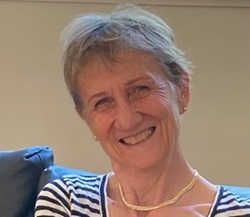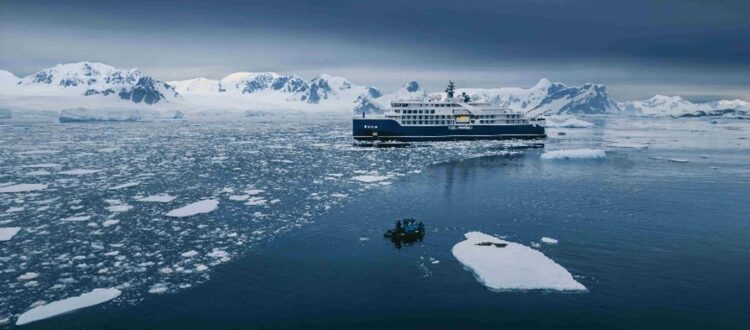Swan Hellenic announces the top scientists on board for its 2026 SETI Institute Explore Space at Sea Series
Cultural expedition cruise pioneer unveils 10 exceptional voyages accompanied by 11 world-class scientists to expand horizons across the globe and far beyond
Swan Hellenic has again shown why it is the choice of curious adventurers across the generations, announcing full details of its 2026 Explore Space at Sea Series.
These exceptional cultural expedition cruises reach further and deeper, including into the far reaches of space, thanks to a unique partnership with the SETI Institute, an offshoot of NASA’s High Resolution Microwave Survey, which began life more than 40 years ago, focused on the search for extraterrestrial intelligence (SETI).
The 2026 series will feature eleven renowned SETI Institute scientists, one per cruise, with the exception of a very special voyage from Chile to Peru at the end of March/beginning of April, which will be accompanied by two research astronomers so guests can take full advantage of Chile’s outstandingly clear skies for stargazing.
These ten extraordinary voyages will consequently bring Swan Hellenic guests specialist insights into the history and latest discoveries in astronomy, astrophysics, astrobiology and planetary science, as well as the quest to find other forms of life within and beyond our solar system.
Each SETI Institute scientist brings their own expert perspective, accompanying guests on their expeditions and delivering thought-provoking lectures aboard, while also mixing and socialising with guests throughout their voyage in the Swan Hellenic tradition.
So, let’s get to know Swan Hellenic’s 2026 SETI Institute scientists, the cruises they will be accompanying and the lectures they will be giving on board.
 Tom Esposito – Research Astronomer at the SETI Institute
Tom Esposito – Research Astronomer at the SETI Institute
Accompanying: From Chile to Peru on SH Vega, March 30 – April 8, 2026
Itinerary: From Valparaiso to Callao and the Peruvian capital Lima over 9 nights, exploring the Atacama Desert, Nazca Lines, extraordinary night skies and much more.
A SETI Institute research astronomer specializing in exoplanet detection, young planetary systems, and high-energy phenomena like supernovae, Dr. Esposito leads two NASA-funded programs with the Unistellar Network.
Tom’s lecture topics will be: “Planet Family Portraits: Photographing Young Solar Systems” – The advanced telescopes that capture light from young exoplanets to reveal their formative years. “Cosmic Cataclysms: Things That Go BOOM! in the Night” – The most powerful explosions in the universe help us understand the origins of life’s building blocks. “Planetary Defence to Planet Discovery: Citizen Astronomy in Action” – How citizens exploring the night sky can contribute to key science.
 James De Buizer – Research Astronomer at the SETI Institute
James De Buizer – Research Astronomer at the SETI Institute
Accompanying: From Chile to Peru on SH Vega, March 30 – April 8, 2026
Itinerary: From Valparaiso to Callao and the Peruvian capital Lima over 9 nights, exploring the Atacama Desert, Nazca Lines, extraordinary night skies and much more.
Dr. De Buizer is a Research Scientist at the Carl Sagan Center for Research at the SETI Institute, and a former aeronaut and Assistant Director of NASA’s Stratospheric Observatory for Infrared Astronomy, the world’s largest flying observatory.
Jim’s lecture topics will be: “Is Anybody Out There? The History of the Search for Civilized Life in the Universe” – The search for extraterrestrial intelligence, from the earliest musings centuries ago to present efforts, including those of the SETI Institute. “Exploring the Mysteries of the Universe from Chile” – By 2030, Chile will be home to more than 50% of the world’s astronomical telescopes. A look at why Chile is so exceptional for astronomical science, what unique observatories are located there, and the exciting discoveries about our Universe they have enabled.
 Simon George – Astrobiologist and experimental research scientist at the SETI Institute
Simon George – Astrobiologist and experimental research scientist at the SETI Institute
Accompanying: From Canada to Iceland on SH Vega, May 18 –29, 2026
Itinerary: From Halifax along the Newfoundland coast to Greenland and Iceland over 11 nights. A voyage through colonial, Viking and Inuit history, exploring some of the world’s great remaining wilderness areas and their fascinating wildlife.
An astrobiologist focusing on the role of metals like iron, nickel, zinc, and molybdenum in the chemistry of life, Dr. George studies the origins, evolution, distribution and future of life in the universe.
Simon’s lecture topics will be: “Living Under Ice and Beside Volcanoes – Life in Extreme Conditions” – How organisms adapt to life in extreme environments on Earth, and how this informs the search for life on other worlds. “Are We Alone? – The Search for Life Elsewhere in the Universe” – How SETI Institute scientists are uncovering clues about life beyond Earth, from Mars to distant exoplanets. “Four Billion Years of Life on Earth” – A journey through Earth’s history to discover the origins of life, intelligence and consciousness.
 Stephen Cramer – Senior Research Scientist at the SETI Institute
Stephen Cramer – Senior Research Scientist at the SETI Institute
Accompanying: Odyssey of Lights: From Iceland to the Lofoten Islands on SH Vega, May 29 – June 10, 2026
Itinerary: An unforgettable luxury cruise north and west from Reykjavik, Iceland, to Tromsø, Norway, experiencing the raw power of nature in volcanic landscapes and breathtaking fjords over 12 nights.
Advanced Light Source Professor Emeritus at UC Davis and an expert in bioinorganic chemistry and biophysics, Dr. Cramer’s work at the intersection of chemistry and biology seeks to reveal the molecular mechanisms of life.
Stephen’s lecture topics will be: “‘Extremophiles’ – From Iceland’s Hot Springs to Norway’s Permafrost” – The organisms at home in the world’s most extreme environments, and what they teach for finding life elsewhere in the universe “Wrong – How Science is Never Quite Right” – How science evolves over time to move closer to the truth. “The World’s Brightest X-Ray Light Bulbs” – Powerful cutting-edge X-ray sources, and their applications in drug development, energy solutions, and understanding photosynthesis.
Orkan Umurhan – Mathematical Physicist at the SETI Institute
Accompanying: In-Depth Svalbard Cruise on SH Vega, June 29 – July 8, 2026
Itinerary: An immersive, 9-night round trip exploration of the vast remote landscapes of the Svalbard archipelago, sailing from the world’s northernmost town, Longyearbyen on the island of Spitsbergen.
Dr. Umurhan is a mathematical physicist and planetary scientist, specializing in planetary formation and the evolution of icy landscapes from Earth to Pluto. He served as a NASA mission scientist on projects such as New Horizons.
Orkan’s lecture topics will be: “Turbulent Cosmogenesis” – The central role that turbulence plays in the formation of the universe, from chaos to order. “Searching for ET Life Across the Solar System” – How life might survive in extreme environments, from deep-sea vents to frozen worlds. “The Grand Icy Landscapes of the Solar System” – A visual tour of the solar system’s exotic icy worlds, comparing them to Earth’s Arctic landscapes.
 Eduardo Bendek – Senior Optical Scientist at the SETI Institute
Eduardo Bendek – Senior Optical Scientist at the SETI Institute
Accompanying: Iceland to Greenland Cruise on SH Vega, August 15–27, 2026
Itinerary: A 12-night voyage of discovery, from Reykjavik’s iconic Hallgrímskirkja church and Harpa Concert Hall to Greenland’s majestic fjords, stunning glaciers and Inuit cultural sites.
Dr. Bendek focuses on designing the technology to detect exoplanets, working on groundbreaking projects such as the Very Large Telescope in Chile and NASA’s Jet Propulsion Laboratory.
Eduardo’s lecture topics will be: “The Search for Earth-Twins Around Nearby Stars, Particularly Alpha Centauri” – The quest to find Earth-like planets around nearby stars. “NASA’s Great Space Observatories and Their Science Cases, Including the Future Habitable Worlds Observatory” – How NASA’s space observatories like Hubble, Webb, and Chandra have revolutionized our understanding of the universe. “Glaciers and Volcanoes in Iceland and Greenland and Their Rapid Evolution in the Last Decades” – How the landscapes of Iceland and Greenland have undergone rapid evolution due to climate change.
Bill Diamond – President and CEO of the SETI Institute
Accompanying: Iceland and British Isles Cruise on SH Diana, August 17–28, 2026
Itinerary: From Reykjavik to Dublin over 11 nights, immersed in the natural beauty and rich history of the North Atlantic, including one-of-kind sites such as the Giant’s Causeway and neolithic Skara Brae.
Bill is a Silicon Valley technology veteran with over 30 years’ experience in laser photonics and optical communications networks, X-ray imaging, and semiconductor processing technologies.
Bill’s lecture topics will be: “From Newgrange to JWST: A 5000-Year Retrospective on Our Place in the Universe” – Key moments in astronomy and the evolution of our understanding of stars, galaxies, and planets. “The Search for Life Beyond Earth – How it Works, How it’s Going, and Why it Matters” – The tools and technologies SETI Institute scientists use to investigate one of life’s most profound questions: are we alone in the universe? “Astrobiology Field Expeditions and the Search for Life Beyond Earth” – How the fieldwork conducted by astrobiologists all over the world relates to SETI’s search for life beyond Earth.
 Marziye Jafariyazani – Senior Optical Scientist at the SETI Institute
Marziye Jafariyazani – Senior Optical Scientist at the SETI Institute
Accompanying: Greenland in Depth Cruise on SH Vega, August 27– September 3, 2026
Itinerary: A 7-night roundtrip voyage from Nuuk, immersing guests in the magic of Disko Bay, the volcanic landscapes of Disko Island and the breathtaking sight of colossal icebergs calving into the sea from the Sermeq Kujalleq Glacier.
Dr. Jafariyazani is part of the Science Processing Operations Center for NASA’s Transiting Exoplanet Survey Satellite Mission at NASA’s Ames Research Center.
Marziye’s lecture topics will be: “Discovering Alien Worlds: How We Search for New Planets Beyond Our Solar System” – The techniques such as starlight dips and stellar wobbles that scientists use to discover distant planets. “Greenland, Ice, and the Search for Life: What Earth’s Extremes Teach Us About Other Worlds” – How Earth’s extreme environments help us unlock clues about the potential for life on other worlds. “Galaxies Beyond Our Own: A Journey Through the Extragalactic Universe” – How astronomers study the chemical signatures of the universe’s farthest galaxies to understand their formation and evolution.
Peter Tenenbaum – Senior Pipeline Architect at the SETI Institute
Accompanying: Atlantic Cruise from Portugal to Senegal on SH Diana, September 7–16, 2026
Itinerary: An extraordinarily varied 9-night voyage from Lisbon through the Canary Islands and on to Morocco, Mauritania and Senegal, travelling through lush green landscapes, volcanic terrain and dramatic desert, with every journey enriched by very different vibrant cultures.
Dr. Tenenbaum analyzed data and developed tools for the Kepler mission before transitioning to the Transiting Exoplanet Survey Satellite mission, where he became Lead Software Engineer for its Science Processing Center at NASA’s Ames Research Center.
Peter’s lecture topics will be: “A Brief History of the Speed of Light” – The fascinating history of how the speed of light was measured, and the key 20th-century scientific breakthroughs to which this led. “Planets, Planets Everywhere” – How astronomers first observed wandering stars and realized that planets orbit stars, plus the thousands of exoplanets since discovered, and their diverse properties.
 Cristina Dalle Ore – Senior Planetary Scientist at the SETI Institute
Cristina Dalle Ore – Senior Planetary Scientist at the SETI Institute
Accompanying: Arctic Cruise from Greenland to Canada & the Northern Lights on SH Vega, September 17–30, 2026
Itinerary: From Nuuk north along the west coast of Greenland to sail a legendary route, crossing to Newfoundland and then exploring south to Halifax over 14 days rich in arctic wildlife and natural wonders, together with Inuit, Viking and colonial history.
Dr. Dalle Ore is a planetary scientist, NASA researcher and key contributor to the New Horizons mission to Pluto and Cassini mission to Saturn. Her discovery of ammonia on Pluto was a landmark.
Cristina’s lecture topics will be: “From Pluto to the Polar Seas: What the Edges of Our Solar System Teach Us About Earth” – How space exploration tools help us understand and protect our planet’s most fragile regions. “Oceans Beyond Earth: The Search for Life in the Outer Solar System” – The hidden oceans beneath the ice of moons like Europa, Enceladus and Titan, and what they reveal about the potential for life. “Mapping the Unknown: Planetary Geology and the Legacy of Exploration” – How planetary geology uses remote sensing and spectral analysis to uncover the geological stories of distant worlds, allowing us to understand other planets and our own polar frontiers.
Michael Lam – Research Scientist at the SETI Institute
Accompanying: Western Europe Cruise from Ireland to Portugal on SH Diana, August 28 – September 7, 2026
Itinerary: A 10-night voyage from Dublin to Lisbon, exploring the richly varied landscapes, wildlife and foundational cultures of Atlantic Europe, from the Celts and Romans to the Goths and Moors.
Dr. Lam is a SETI Institute research scientist and a member of the North American Nanohertz Observatory for Gravitational Waves. His research spans radio telescopes, pulsar observations, interstellar gas physics, and gravitational wave observation.
Michael’s lecture topics will be: “The Race for Neptune” – The historic race to find Neptune beyond Uranus. “Estimating the Drake Equation” – Frank Drake’s 1961 equation for determining the number of communicating civilizations in the Milky Way, and the challenges of assessing how common or rare civilizations like ours might be. “The Currents of Interstellar Space” – A dive into the interstellar medium, a mix of gas and particles between stars, learning how its dynamics impact astrophysical processes, radio waves, and our search for extraterrestrial technosignatures.
Patrizia Iantorno, Chief Commercial Officer of Swan Hellenic commented: “We’re very proud to unveil these unique 2026 Explore Space at Sea cruises with our partners at SETI, offering ten very different opportunities for curious minds to see what others don’t, both on Earth and beyond”.
A brochure with full details of each cruise and the fascinating specialisations and amazing career achievements of these SETI Institute scientists can be downloaded here below:
SH&SETI together to explore Space and Sea
All these extraordinary Explore Space at Sea cruises are already available to book on the Swan Hellenic Website see below:




